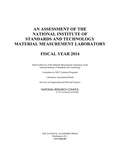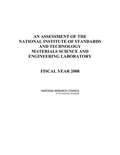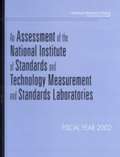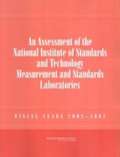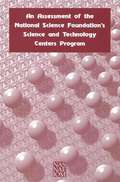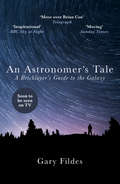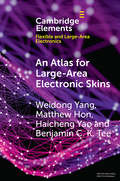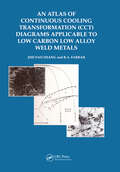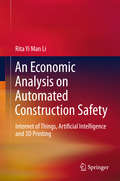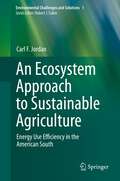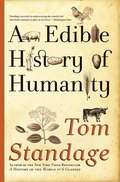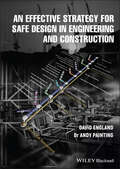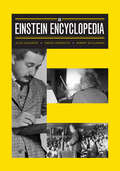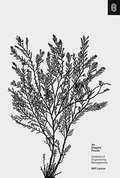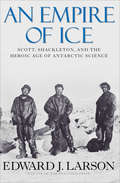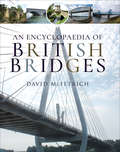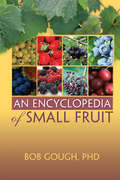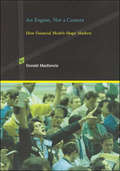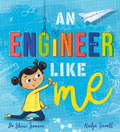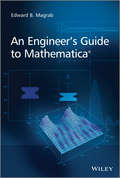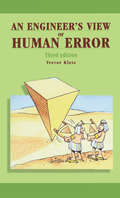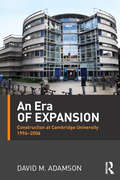- Table View
- List View
An Assessment of the National Institute of Standards and Technology Material Measurement Laboratory: Fiscal Year 2014
by Technology Panel on Review of the Material Measurement Laboratory at the National Institute of StandardsThe National Institute of Standards and Technology's (NIST's) Material Measurement Laboratory (MML) is our nation's reference laboratory for measurements in the chemical, biological, and materials sciences and engineering. Staff of the MML develop state-of-the-art measurement techniques and conduct fundamental research related to measuring the composition, structure, and properties of substances. Tools that include reference materials, data, and measurement services are developed to support industries that range from transportation to biotechnology and to address problems such as climate change, environmental sciences, renewable energy, health care, infrastructure, food safety and nutrition, and forensics. This report assesses the scientific and technical work performed by NIST's Material Measurement Laboratory. In particular, the report assesses the organization's technical programs, the portfolio of scientific expertise within the organization, the adequacy of the organization\'s facilities, equipment, and human resources, and the effectiveness by which the organization disseminates its program outputs.
An Assessment of the National Institute of Standards and Technology Materials Science and Engineering Laboratory
by National Research Council Division on Engineering and Physical Sciences Laboratory Assessments Board Panel on Materials Science and EngineeringThe Materials Science and Engineering Laboratory (MSEL) of the National Institute of Standards and Technology (NIST) works with industry, standards bodies, universities, and other government laboratories to improve the nation's measurements and standards infrastructure for materials. A panel of experts appointed by the National Research Council (NRC) assessed the four divisions of MSEL, by visiting these divisions and reviewing their activities. This book concludes that, for the selected portion of the MSEL programs reviewed, the staff, the projects, and many facilities are outstanding. The projects are clearly focused on the mission of MSEL. The facilities and equipment are rationally upgraded within budget constraints, with several facilities being unique; the funding provided through the America COMPETES Act of 2007 is being used effectively. Division chiefs and staff evinced high morale, attributable to several factors: clear definitions of expectations and of the processes for realizing them, strong support of the MSEL from NIST leadership and of NIST generally from the President and from the Congress (through the American Competitiveness Initiative and the America COMPETES Act), and positive feedback from customers.
An Assessment of the National Institute of Standards and Technology Measurement and Standards Laboratories: FISCAL YEAR 2002
by National Academy of Science the National AcademiesThe National Academies Press (NAP)--publisher for the National Academies--publishes more than 200 books a year offering the most authoritative views, definitive information, and groundbreaking recommendations on a wide range of topics in science, engineering, and health.<P><P> Our books are unique in that they are authored by the nation's leading experts in every scientific field.
An Assessment of the National Institute of Standards and Technology Measurement and Standards Laboratories: FISCAL YEARS 2004 - 2005
by National Research Council of the National AcademiesThe National Institute of Standards and Technology (NIST) Measurements and Standards Laboratories (MSL) provide technical leadership for the nation’s measurement and standards infrastructure and assure the availability of essential reference data and measurement capabilities. <P><P>At NIST’s request the National Research Council (NRC) carries out a biennial assessment of the seven MSL. The assessment focuses on each laboratory’s technical quality and merit; and effectiveness. It also examines the relevance of the NIST programs and how well laboratory facilities, equipment, and personnel are able to fulfill the MSL mission. This report presents an overall assessment of the MSL followed by detailed assessments of each of the seven laboratories.
An Assessment of the National Science Foundation's Science and Technology Centers Program
by Committee on Science Engineering Public PolicyAn Assessment of the National Science Foundation's Science and Technology Centers Program
An Assessment of the Science Proposed for the Deep Underground Science and Engineering Laboratory(DUSEL)
by Ad Hoc Committee to Assess the Science Proposed for a Deep Underground Science Engineering LaboratoryAccording to the big bang theory, our Universe began in a state of unimaginably high energy and density, contained in a space of subatomic dimensions. At that time, unlike today, the fundamental forces of nature were presumably unified and the particles present were interacting at energies not attainable by present-day accelerators. Underground laboratories provide the conditions to investigate processes involving rare phenomena in matter and to detect the weak effects of highly elusive particles by replicating similar environments to those once harnessed during the earliest states of the Earth. These laboratories now appear to be the gateway to understanding the physics of the grand unification of the forces of nature. Built to shield extremely sensitive detectors from the noise of their surroundings and the signals associated with cosmic rays, underground facilities have been established during the last 30 years at a number of sites worldwide. To date, the United States' efforts to develop such facilities have been modest and consist primarily of small underground laboratories. However, the U. S. underground community has pushed for larger underground facilities on the scale of major laboratories in other countries. An Assessment of the Deep Underground Science and Engineering Laboratory (DUSEL) addresses this matter by evaluating the major physics questions and experiments that could be explored with the proposed DUSEL. Measuring the potential impact, this assessment also examines the broader effects of the DUSEL in regards to education and public outreach, and evaluates the need associated with developing U. S. programs similar to science programs in other regions of the world.
An Astronaut's Guide to Life on Earth: What Going To Space Taught Me About Ingenuity, Determination, And Being Prepared For Anything
by Chris HadfieldAs Commander of the International Space Station, Chris Hadfield captivated the world with stunning photos and commentary from space. Now, in his first book, Chris offers readers extraordinary stories from his life as an astronaut, and shows how to make the impossible a reality. Chris Hadfield decided to become an astronaut after watching the Apollo moon landing with his family on Stag Island, Ontario, when he was nine years old, and it was impossible for Canadians to be astronauts. In 2013, he served as Commander of the International Space Station orbiting the Earth during a five-month mission. Fulfilling this lifelong dream required intense focus, natural ability and a singular commitment to &“thinking like an astronaut.&” In An Astronaut&’s Guide to Life on Earth, Chris gives us a rare insider&’s perspective on just what that kind of thinking involves, and how earthbound humans can use it to achieve success and happiness in their lives.Astronaut training turns popular wisdom about how to be successful on its head. Instead of visualizing victory, astronauts prepare for the worst; always sweat the small stuff; and do care what others think. Chris shows how this unique education comes into play with dramatic anecdotes about going blind during a spacewalk, getting rid of a live snake while piloting a plane, and docking with space station Mir when laser tracking systems fail at the critical moment. Along the way, he shares exhilarating experiences, and challenges, from his 144 days on the ISS, and provides an unforgettable answer to his most-asked question: What&’s it really like in outer space?Written with humour, humility and a profound optimism for the future of space exploration, An Astronaut&’s Guide to Life on Earth offers readers not just the inspiring story of one man&’s journey to the ISS, but the opportunity to step into his space-boots and think like an astronaut—and renew their commitment to pursuing their own dreams, big or small.
An Astronomer's Tale: A Bricklayer’s Guide to the Galaxy
by Gary FildesA Bricklayer's Guide to the Galaxy . . . The inspirational memoir of a former brickie who followed his passion for the stars and built his own observatory. Perfect for readers of Robert Macfarlane, Helen Macdonald and James Rebanks - as well as fans of Brian Cox and the BBC’s Sky at Night Gary Fildes left school at sixteen, got a trade like most of his mates and was soon married with four kids. His life seemed set. But he had a secret. Something he only practised late at night with a few like-minded friends. Then one day, middle age approaching alarmingly, he acted on his lifelong passion. He finally came out. As an astronomer.Today, Gary is the founder and lead astronomer of Kielder Observatory, one of the top ten stargazing sites in the world, which he also helped to build. Situated in the beautiful forests of Kielder, Northumberland, within Europe’s largest protected dark sky park, it offers some of the UK's most spectacular views of stars, planets and galaxies.An Astronomer’s Tale is Gary’s inspirational story: part memoir, part nature writing, part seasonal guide to the night sky. It is a book brimming with passion; and at a time when the world is captivated by space, it will leave you ready to get out there and explore the wonders of the skies for yourself.
An Atlas for Large-Area Electronic Skins: From Materials to Systems Design (Elements in Flexible and Large-Area Electronics)
by Weidong Yang Matthew Hon Haicheng Yao Benjamin C. TeeElectronic skins are critical for many applications in human-machine-environment interactions. Tactile sensitivity over large areas can be especially applied to prosthetics. Moreover, the potential for wearables, interactive surfaces, and human robotics have propelled research in this area. In this Element, we provide an account and directional atlas of the progress in materials and devices for electronic skins, in the context of sensing principles and skin-like features. Additionally, we give an overview of essential electronic circuits and systems used in large-area tactile sensor arrays. Finally, we present the challenges and provide perspectives on future developments.
An Atlas of Continuous Cooling Transformation (CCT) Diagrams Applicable to Low Carbon Low Alloy Weld Metals
by Zhuyo ZhangThis atlas is a collection of continuous cooling transformation diagrams applicable to low carbon low alloy weld metals. It will be of assistance to welding engineers, welding metallurgists, welding-consumables designers in industry.
An Economic Analysis on Automated Construction Safety
by Rita Yi LiThis book addresses information technologies recently applied in the field of construction safety. Combining case studies, literature reviews and interviews to study the issue, it presents cutting-edge applications of various information technologies (ITs) in construction in different parts of the world, together with a wealth of figures, tables and examples. Though primarily intended for researchers and experts in the field, the book will also benefit graduate students.
An Economic History of Europe
by Karl Gunnar PerssonThis concise introduction is the only textbook students will need to understand Europe's unique economic development and its global context.
An Ecosystem Approach to Sustainable Agriculture: Energy Use Efficiency in the American South (Environmental Challenges and Solutions #1)
by Carl F. JordanModern industrial agriculture is not sustainable because of its heavy reliance on petroleum, a non-renewable source of the energy used in farming, and because of pollution caused by petroleum products such as fertilizers and pesticides. A systems analysis of farming suggests that agriculture will be more sustainable when services of nature, such as nutrient recycling by soil micro-organisms and natural controls of insects, replace the services now provided by energy from petroleum. Examples are drawn from the Southeastern USA, but lessons learned can be applied worldwide.
An Edible History of Humanity
by Tom StandageIn this book, Tom Standage charts the enlightening history of humanity through the foods we eat. More than simply sustenance, food historically has been a kind of technology, changing the course of human progress by helping to build empires, promote industrialization, and decide the outcomes of wars. Tom Standage draws on archaeology, anthropology, and economics to reveal how food has helped shape and transform societies around the world, from the emergence of farming in China by 7500 b.c. to the use of sugar cane and corn to make ethanol today.
An Effective Strategy for Safe Design in Engineering and Construction
by David England Dr. Andy PaintingAN EFFECTIVE STRATEGY FOR SAFE DESIGN IN ENGINEERING AND CONSTRUCTION Practically and efficiently implement the Construction (Design and Management) Regulations in any project In An Effective Strategy for Safe Design, safety and risk professionals David England and Dr Andy Painting provide a comprehensive exploration of the design process, from initial idea to the validation of the product in service, from a product and project safety perspective. In that context, the authors show how the appropriate implementation of the requirements of the Construction (Design and Management) Regulations 2015 can not only improve health and safety on a project but can also improve the project’s output as well as offering savings in both capital and operational expenditure. Readers will discover how the seemingly complex matters of regulation and risk management can be practically applied to projects via examples, illustrations, and real-world references. They will find out how safety regulation, standards, and initiatives all converge on the same goal—the safest output from any given project. The book achieves three primary goals: To improve the understanding and implementation of the Construction (Design and Management) Regulations 2015 To reduce errors during the design process via the effective implementation of design management strategy To embed the concept of safety in design Perfect for designers, design managers and supervisors, project managers, surveyors, and insurers, An Effective Strategy for Safe Design is also an invaluable addition to the libraries of principal designers, specifiers, and building control officers.
An Einstein Encyclopedia
by Alice Calaprice Robert Schulmann Daniel KennefickThis is the single most complete guide to Albert Einstein's life and work for students, researchers, and browsers alike. Written by three leading Einstein scholars who draw on their combined wealth of expertise gained during their work on the Collected Papers of Albert Einstein, this authoritative and accessible reference features more than one hundred entries and is divided into three parts covering the personal, scientific, and public spheres of Einstein's life.An Einstein Encyclopedia contains entries on Einstein's birth and death, family and romantic relationships, honors and awards, educational institutions where he studied and worked, citizenships and immigration to America, hobbies and travels, plus the people he befriended and the history of his archives and the Einstein Papers Project. Entries on Einstein's scientific theories provide useful background and context, along with details about his assistants, collaborators, and rivals, as well as physics concepts related to his work. Coverage of Einstein's role in public life includes entries on his Jewish identity, humanitarian and civil rights involvements, political and educational philosophies, religion, and more.Commemorating the hundredth anniversary of the theory of general relativity, An Einstein Encyclopedia also includes a chronology of Einstein's life and appendixes that provide information for further reading and research, including an annotated list of a selection of Einstein's publications and a review of selected books about Einstein.More than 100 entries cover the rich details of Einstein's personal, professional, and public lifeAuthoritative entries explain Einstein's family relationships, scientific achievements, political activities, religious views, and moreMore than 40 illustrations include photos of Einstein and his circle plus archival materialsA chronology of Einstein's life, appendixes, and suggestions for further reading provide essential details for further research
An Elegant Puzzle: Systems Of Engineering Management
by Will LarsonThere's a saying that people don't leave companies, they leave managers. Management is a key part of any organization, yet the discipline is often self-taught and unstructured. Getting to the good solutions of complex management challenges can make the difference between fulfillment and frustration for teams, and, ultimately, the success or failure of companies. <p><p> Will Larson's An Elegant Puzzle orients around the particular challenges of engineering management--from sizing teams to technical debt to succession planning--and provides a path to the good solutions. Drawing from his experience at Digg, Uber, and Stripe, Will Larson has developed a thoughtful approach to engineering management that leaders of all levels at companies of all sizes can apply. An Elegant Puzzle balances structured principles and human-centric thinking to help any leader create more effective and rewarding organizations for engineers to thrive in.
An Empire of Ice: Scott, Shackleton, and the Heroic Age of Antarctic Science (Playaway Adult Nonfiction Ser.)
by Edward J. LarsonA Pulitzer Prize–winning author examines South Pole expeditions, &“wrapping the science in plenty of dangerous drama to keep readers engaged&” (Booklist). An Empire of Ice presents a fascinating new take on Antarctic exploration—placing the famed voyages of Norwegian explorer Roald Amundsen, his British rivals Robert Scott and Ernest Shackleton, and others in a larger scientific, social, and geopolitical context. Recounting the Antarctic expeditions of the early twentieth century, the author reveals the British efforts for what they actually were: massive scientific enterprises in which reaching the South Pole was but a spectacular sideshow. By focusing on the larger purpose of these legendary adventures, Edward J. Larson deepens our appreciation of the explorers&’ achievements, shares little-known stories, and shows what the Heroic Age of Antarctic discovery was really about. &“Rather than recounting the story of the race to the pole chronologically, Larson concentrates on various scientific disciplines (like meteorology, glaciology and paleontology) and elucidates the advances made by the polar explorers . . . Covers a lot of ground—science, politics, history, adventure.&” —The New York Times Book Review
An Encyclopaedia of British Bridges
by David McFetrich&“An already impressive reference work has been made significantly more valuable . . . a well-illustrated alphabetized compendium of notable bridges.&” —The Happy Pontist Bridges have a universal appeal as examples of man&’s mastery of nature, from picturesque packhorse bridges to great spans stretching across broad estuaries, and the development of the technology that allows ever more audacious constructions is never-ending. Of the million or more bridges throughout Great Britain, David McFetrich has selected those that are significant in terms of their design, construction or location, or of their connections with people or events of history. His definitive book contains 1,600 separate entries for individual bridge sites or related groups of bridges covering more than 2,000 different structures, 165 general entries about different types of bridge and such topics as collapses and failures, and a summary of about 200 record-holding bridges in 50 different categories. The concise text is supported by more than 900 illustrations and diagrams. The result is a fascinating and readily accessible compendium. The Institute of Civil Engineers (ICA) is also on board. &“A valuable resource to use . . . if you plan to visit some of these structures while on holiday or are merely planning a day out.&” —East Yorkshire Family History Society &“Well-written and researched and eminently readable . . . Because of the ubiquity of bridges throughout Great Britain, this volume should have wide appeal.&” —NZ Crown Mines &“Full of details covering the many bridges around the UK . . . I found it fascinating to see the variety of bridges around Britain, even the ones not railway related.&” —Rail Advent
An Encyclopedia of Small Fruit
by Robert E GoughAn A-to-Z look at the world of small fruits While there are many books on small fruit culture, their focus is often very specific or confined to just a few species. Packed with useful information, An Encyclopedia of Small Fruit is the comprehensive A-to-Z reference that not only details all temperate and tropical small fruit grown throu
An Engine, Not a Camera: How Financial Models Shape Markets (Inside Technology)
by Donald MacKenzieIn An Engine, Not a Camera, Donald MacKenzie argues that the emergence of modern economic theories of finance affected financial markets in fundamental ways. These new, Nobel Prize-winning theories, based on elegant mathematical models of markets, were not simply external analyses but intrinsic parts of economic processes.Paraphrasing Milton Friedman, MacKenzie says that economic models are an engine of inquiry rather than a camera to reproduce empirical facts. More than that, the emergence of an authoritative theory of financial markets altered those markets fundamentally. For example, in 1970, there was almost no trading in financial derivatives such as "futures." By June of 2004, derivatives contracts totaling $273 trillion were outstanding worldwide. MacKenzie suggests that this growth could never have happened without the development of theories that gave derivatives legitimacy and explained their complexities.MacKenzie examines the role played by finance theory in the two most serious crises to hit the world's financial markets in recent years: the stock market crash of 1987 and the market turmoil that engulfed the hedge fund Long-Term Capital Management in 1998. He also looks at finance theory that is somewhat beyond the mainstream—chaos theorist Benoit Mandelbrot's model of "wild" randomness. MacKenzie's pioneering work in the social studies of finance will interest anyone who wants to understand how America's financial markets have grown into their current form.
An Engineer Like Me
by Dr Shini SomaraInventive illustrations and an empowering story combine to introduce young readers to the world of engineering, creative thinking and problem-solving.Zara is curious about everything! Travelling around the city with her gran, she sees all kinds of fascinating things. How do roller coasters do loop-the-loops? How do planes stay up? As she marvels about how they work, Zara learns about some of the brilliant engineers who have shaped the world around her. Soon she can't wait to start creating her own amazing inventions and become an engineer too!With pages encouraging kids to try out their very own engineering experiments such as constructing the perfect paper aeroplane and safely dropping an egg from a height, this brilliant picture book written by engineer and TV presenter Dr Shini Somara unlocks a love of engineering and celebrates women in STEM.The first book in an exciting new series. Still to come:- A Scientist Like Me- A Coder Like Me- A Mathematician Like Me
An Engineer's Guide to Mathematica
by Edward B. MagrabFree Mathematica 10 Update Included! Now available from www.wiley.com/go/magrab Updated material includes:- Creating regions and volumes of arbitrary shape and determining their properties: arc length, area, centroid, and area moment of inertia- Performing integrations, solving equations, and determining the maximum and minimum values over regions of arbitrary shape- Solving numerically a class of linear second order partial differential equations in regions of arbitrary shape using finite elements An Engineer's Guide to Mathematica enables the reader to attain the skills to create Mathematica 9 programs that solve a wide range of engineering problems and that display the results with annotated graphics. This book can be used to learn Mathematica, as a companion to engineering texts, and also as a reference for obtaining numerical and symbolic solutions to a wide range of engineering topics. The material is presented in an engineering context and the creation of interactive graphics is emphasized. The first part of the book introduces Mathematica's syntax and commands useful in solving engineering problems. Tables are used extensively to illustrate families of commands and the effects that different options have on their output. From these tables, one can easily determine which options will satisfy one's current needs. The order of the material is introduced so that the engineering applicability of the examples increases as one progresses through the chapters. The second part of the book obtains solutions to representative classes of problems in a wide range of engineering specialties. Here, the majority of the solutions are presented as interactive graphics so that the results can be explored parametrically. Key features: Material is based on Mathematica 9 Presents over 85 examples on a wide range of engineering topics, including vibrations, controls, fluids, heat transfer, structures, statistics, engineering mathematics, and optimization Each chapter contains a summary table of the Mathematica commands used for ease of reference Includes a table of applications summarizing all of the engineering examples presented. Accompanied by a website containing Mathematica notebooks of all the numbered examples An Engineer's Guide to Mathematica is a must-have reference for practitioners, and graduate and undergraduate students who want to learn how to solve engineering problems with Mathematica.
An Engineer's View of Human Error, Third Edition
by Trevor KletzThis title looks at how people, as opposed to technology and computers, are arguably the most unreliable factor within plants, leading to dangerous situations.
An Era of Expansion: Construction at the University of Cambridge 1996–2006
by David M. AdamsonChanging conditions in Higher Education and national funding regimes preceded a proliferation of construction projects in universities between 1996 and 2006. This book reviews a hundred projects between 1996 and 2006, and uses 9 detailed case studies from the author's time in charge of capital projects at the University of Cambridge to show us how these projects were conceived, argued for, designed, procured, managed, constructed, and passed on to building users. Readers with an interest in project management, estate management, University management, or the history of the University of Cambridge will find this fascinating and wide-ranging book to be uniquely valuable.
